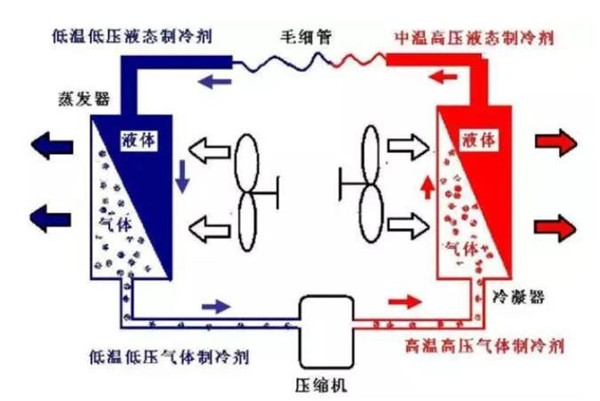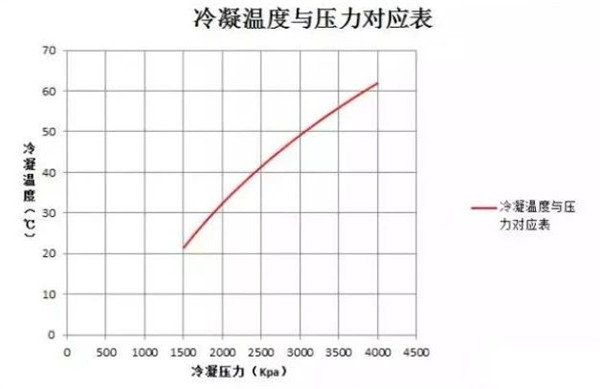News Center
- Influence of evaporation and condensation pressure on refrigeration system
- date: 2020-1-9 hits:1172
When a failure occurs in a refrigeration system, it is generally impossible to see directly where the failure site occurs, nor is it possible to dissect and dissect the components of the refrigeration system one by one. Only by looking at the surface can abnormal phenomena be found in operation, for a comprehensive analysis. It is very important to measure the pressure and temperature of the refrigeration system.
1, Suction pressure and exhaust pressure: Refrigeration System in operation can be divided into high and low pressure two parts. Exhaust pressure refers to the exhaust pipe at the compressor outlet refrigerant gas pressure. The compressor suction pressure is called suction pressure, suction pressure close to the evaporation pressure. The difference between the two is the flow resistance of the pipeline.
For convenience, the evaporating pressure and condensing pressure of the refrigeration system are detected at the suction and exhaust ports of the compressor. That is often called the compressor suction, exhaust pressure. The purpose of measuring the suction and exhaust pressure of refrigeration system is to obtain the evaporating temperature and condensing temperature of refrigeration system, so as to obtain the running status of refrigeration system.
2. Condensation pressure: Condensation pressure is the pressure at which the refrigerant condenses the gas into a liquid in the condenser. Since the pressure inside the condenser in the refrigeration system can not be measured, refrigerant in the exhaust pipe and condenser pressure drop is very small, so regardless of design commissioning or maintenance, generally think that the exhaust pressure is approximately equal to condensation pressure. Condensing temperature versus refrigerating capacity: Let's look briefly at the relationship between the condensing pressure of R22 refrigerant and the condensing temperature:
As can be seen from the diagram, the condensing temperature and condensing pressure are in direct proportion, the condensing pressure and condensing temperature are corresponding; the lower the condensing pressure (high pressure) , the lower the condensing temperature; the higher the condensing pressure (high pressure) , the higher the condensation temperature. Knowing the condensing pressure, we can look up the table and get the value of the condensing temperature. Heat load and condensation pressure relationship: This is simply the condensation side of the load and condensation pressure relationship. In a constant operating condition (refrigerant flow) , the greater the heat load, the higher the condensation pressure, and vice versa. We can imagine that when you design the condenser small (heat load is relatively large) , the refrigeration system is very easy to high-pressure alarm. The influence factor of refrigeration system pressure 1, the factor of low suction pressure: The suctionpressure is lower than the normal value, the factors include insufficient refrigeration capacity, small cooling load, small expansion valve opening degree, low condensing pressure (refers to the capillary system) , and the filter isn't working. High Suction pressure factors: Suction pressure higher than normal, its factors are too much refrigerant, refrigeration load, expansion valve opening, high condensation pressure (capillary system) and compressor efficiency. 2, exhaust pressure, high exhaust pressure factors: When the exhaust pressure is higher than the normal value, there is generally a cooling medium of low flow or high temperature, refrigerant charge too much, large cooling load and expansion valve open degree. These results result in the increase of circulating flow and the corresponding increase of condensation heat load. As the heat can not be all out in time, causing condensation temperature rise, and can be detected is the exhaust (condensation) pressure rise. When the flow rate of the cooling medium is low or the temperature of the cooling medium is high, the cooling efficiency of the condenser decreases and the condensing temperature increases. When the flow rate of the cooling medium is low or the temperature of the cooling medium is high, the cooling efficiency of the condenser decreases and the condensing temperature increases. The reason of excessive refrigerant charge is that the surplus refrigerant liquid occupies part of the condenser tube, which reduces the condensing area and causes the condensing temperature to rise. Factors of low exhaust pressure: The exhaust pressure is lower than the normal value. The factors include low efficiency of the compressor, insufficient refrigerants, small cooling load, small expansion valve opening, unblocked filter, including expansion valve filter screen and cooling medium temperature low. Above several kinds of factors all can cause the system the refrigeration flow to drop, the condensation load is small, causes the condensation temperature to drop. From the above suction pressure and exhaust pressure and exhaust pressure changes, there is a close relationship between the two. In general, when the suction pressure rises, the exhaust pressure rises, and when the suction pressure drops, the exhaust pressure drops. Also may estimate from the suction pressure gauge change the exhaust pressure approximate situation.
Warm and cold life, Binger company!
-
pre:Fault analysis of compressor l
next:Warm congratulations on the 70 - back


